Crashworthiness Performance and Multi-Objective Optimization of Bi-Directional Corrugated Tubes under Quasi-Static Axial Crushing
Abstract
:1. Introduction
2. Materials and Methods
2.1. Geometric Features
2.2. Crashworthiness Indicators
- Energy absorption (): This is defined as the area under the force–displacement curve, given by:where denotes the loading force as a function of displacements. represents the effective stroke, which is numerically defined as 70% of the tube length.
- Specific energy absorption (): This metric represents the energy absorption per unit mass and indicates the energy absorption efficiency of the structure. It can be expressed as:
- Initial peak crushing force (): This refers to the maximum force attained on the force–displacement curve following the elastic phase. The force at this peak is termed the .
- Mean crushing force (): is defined as the ratio of to the effective stroke . It can be quantified by the following equation:
- Crushing force efficiency (): ratio of to .
- Undulation of load carrying capacity (): quantifies the smoothness of the force–displacement curve by calculating the ratio of the work done due to deviations of the actual load from the to the . A smaller value signifies a more uniform and smoother energy absorption process.
2.3. Compression Test
2.4. FE Modeling
3. Discussion
3.1. Discrete Parametric Analysis
3.1.1. Effect of and
3.1.2. Selection Method and Results
3.2. Parametric Analysis of Continuous Type Parameters
3.2.1. Deformation Patterns
3.2.2. Crashworthiness Analysis
3.2.3. Comparison between BCTs and CCTs
3.2.4. Comparison between BCTs and LCTs
3.3. Effect of Wall Thickness
4. Optimization
4.1. Definition of the Optimization Problem
4.2. Approximate Model
4.3. Optimization Results
5. Conclusions
- The BCT is fabricated using a bending method, with the accuracy of the finite element model validated by experimental verification.
- Discretization analysis assesses the influence of parameters and on the crashworthiness of the BCT. The TOPSIS ranking method identifies the optimal values for and , which are determined as 12 and 16, respectively.
- A full-parameter design of experiments investigates the effects of , , and on structural crashworthiness. influences the energy absorption capacity, enhances the stability of the platform force, and an increase in improves the likelihood of achieving an optimal energy-absorbing configuration.
- The of the BCT exceeds that of the CCT by up to 80.23%, while the is reduced by 57.63%. Additionally, the of the BCT is decreased by 72.96% compared to the CCT, and it exhibits a 36.43% lower compared to the LCT, with up to 44.9% higher than the LCT.
- A simultaneous multi-objective optimization of CCT, LCT, and BCT based on the NSGAII method reveals that the Pareto front of the BCT demonstrates superior crashworthiness advantages compared to both CCT and LCT. The proposed BCT shows significant potential as an energy absorber with promising applications across various fields.
Author Contributions
Funding
Institutional Review Board Statement
Informed Consent Statement
Data Availability Statement
Conflicts of Interest
Abbreviations
| LCT | longitudinal corrugated tube |
| CCT | circumferential corrugated tube |
| BCT | bi-directional corrugated tube |
| number of units in a single-layer BCT | |
| number of layers in the BCT | |
| amplitude of transverse ripple | |
| amplitude of axial ripples | |
| diameter of the neutral plane of the BCT | |
| wall thickness of the BCT | |
| height of the BCT | |
| distance from the XOZ plane | |
| bending angle | |
| half of the outer diameter of the BCT | |
| energy absorption | |
| specific energy absorption | |
| initial peak crushing force | |
| mean crushing force | |
| crushing force efficiency | |
| undulation of load carrying capacity | |
| density | |
| Young’s modulus | |
| yield stress | |
| Poisson’s ratio | |
| PEEQ | equivalent plastic strain |
| The maximum value of the load in the load displacement curve |
Appendix A
Appendix B
| Tubes | Ranking | Tubes | Ranking | ||
|---|---|---|---|---|---|
| 0.0076 | 19 | 0.2954 | 11 | ||
| 0.2060 | 16 | 0.3533 | 6 | ||
| 0.2816 | 13 | 0.3486 | 7 | ||
| 0.2901 | 12 | 0.3057 | 10 | ||
| 0.1760 | 18 | 0.5116 | 5 | ||
| 0.2518 | 15 | 0.6022 | 4 | ||
| 0.3227 | 9 | 0.6435 | 3 | ||
| 0.3270 | 8 | 0.8101 | 1 | ||
| 0.1766 | 17 | 0.7906 | 2 | ||
| 0.2621 | 14 |
References
- Zhou, X.W.; Liu, J.D.; Rong, W.F.; Wu, B.Y. Axial Crushing Theory and Optimization of Lattice-Filled Multicellular Square Tubes. Materials 2024, 17, 1245. [Google Scholar] [CrossRef]
- Li, W.W.; Li, Z.H.; Li, S.H.; Wang, P. Crushing Behaviors and Energy Absorption Evaluation Methods of Hexagonal Steel Tubular Columns with Triangular Cells. Materials 2022, 15, 3910. [Google Scholar] [CrossRef]
- Tan, X.; Zhu, S.; Wang, B.; Kadic, M. Tuning negative stiffness mechanical metamaterial’s snap-through behavior with a series-connected spring. Eur. J. Mech. A Solids 2024, 107, 105382. [Google Scholar] [CrossRef]
- Zhou, J.; Jia, S.; Qian, J.; Chen, M.; Chen, J. Improving the Buffer Energy Absorption Characteristics of Movable Lander-Numerical and Experimental Studies. Materials 2020, 13, 3340. [Google Scholar] [CrossRef]
- Tan, X.; Cao, B.; Liu, W.; Ji, C.; Wang, B.; Li, S. Odd mechanical metamaterials with simultaneously expanding or contracting under both compression and tension. Thin-Walled Struct. 2024, 203, 112225. [Google Scholar] [CrossRef]
- Xing, J.; Zhao, J.L.; Niu, Q.; Zhang, T.Y.; Zhang, C.Y.; Zhang, Y.L.; Wang, W.Z.; Yan, S.Z.; Liu, X.A. Crashworthiness design and optimization of bamboo-inspired tube with gradient multi-cells. Thin-Walled Struct. 2023, 191, 111034. [Google Scholar] [CrossRef]
- Li, Z.; Chen, W.; Hao, H. Numerical study of open-top truncated pyramid folded structures with interconnected side walls against flatwise crushing. Thin-Walled Struct. 2018, 132, 537–548. [Google Scholar] [CrossRef]
- Liu, Z.L.; Wang, Y.; Liang, X.; Yu, W. Crashworthiness Study of Functional Gradient Lattice-Reinforced Thin-Walled Tubes under Impact Loading. Materials 2024, 17, 2264. [Google Scholar] [CrossRef]
- Tao, C.L.; Zhou, X.; Liu, Z.L.; Liang, X.; Zhou, W.T.; Li, H.J. Crashworthiness Study of 3D Printed Lattice Reinforced Thin-Walled Tube Hybrid Structures. Materials 2023, 16, 1871. [Google Scholar] [CrossRef]
- Wu, S.; Sun, G.; Wu, X.; Li, G.; Li, Q. Crashworthiness analysis and optimization of fourier varying section tubes. Int. J. Non-Linear Mech. 2017, 92, 41–58. [Google Scholar] [CrossRef]
- Deng, X.; Liu, W.; Jin, L. On the crashworthiness analysis and design of a lateral corrugated tube with a sinusoidal cross-section. Int. J. Mech. Sci. 2018, 141, 330–340. [Google Scholar] [CrossRef]
- Deng, X.; Qin, S.; Huang, J. Energy absorption characteristics of axially varying thickness lateral corrugated tubes under axial impact loading. Thin-Walled Struct. 2021, 163, 107721. [Google Scholar] [CrossRef]
- Li, Z.; Yao, S.; Ma, W.; Xu, P.; Che, Q. Energy-absorption characteristics of a circumferentially corrugated square tube with a cosine profile. Thin-Walled Struct. 2019, 135, 385–399. [Google Scholar] [CrossRef]
- Eyvazian, A.; Eltai, E.; Musharavati, F.; Taghipoor, H.; Sebaey, T.A.; Talebizadehsardari, P. Experimental and numerical investigations on axial crushing of square cross-sections tube with vertical wave. Steel Compos. Struct. 2020, 36, 119–141. [Google Scholar] [CrossRef]
- Singace, A.A.; ElSobky, H. Behaviour of axially crushed corrugated tubes. Int. J. Mech. Sci. 1997, 39, 249–261, 263–265, 267–268. [Google Scholar] [CrossRef]
- Eyvazian, A.; Habibi, M.K.; Hamouda, A.M.; Hedayati, R. Axial crushing behavior and energy absorption efficiency of corrugated tubes. Mater. Des. 2014, 54, 1028–1038. [Google Scholar] [CrossRef]
- Dong, J.; Li, W.; Fan, H. Axial crushing behaviors of buckling induced triangular tubular structures. Mater. Des. 2021, 201, 109513. [Google Scholar] [CrossRef]
- Chen, D.H.; Ozaki, S. Numerical study of axially crushed cylindrical tubes with corrugated surface. Thin-Walled Struct. 2009, 47, 1387–1396. [Google Scholar] [CrossRef]
- Eyvazian, A.; Tran, T.N.; Hamouda, A.M. Experimental and theoretical studies on axially crushed corrugated metal tubes. Int. J. Non-Linear Mech. 2018, 101, 86–94. [Google Scholar] [CrossRef]
- Alkhatib, S.E.; Matar, M.S.; Tarlochan, F.; Laban, O.; Mohamed, A.S.; Alqwasmi, N. Deformation modes and crashworthiness energy absorption of sinusoidally corrugated tubes manufactured by direct metal laser sintering. Eng. Struct. 2019, 201, 109838. [Google Scholar] [CrossRef]
- Imai, T.; Shibutani, T.; Matsui, K.; Kumagai, S.; Tran, D.T.; Mu, K.Y.; Maekawa, T. Curvature sensitive analysis of axially compressed cylindrical tubes with corrugated surface using isogeometric analysis and experiment. Comput. Aided Geom. Des. 2016, 49, 17–30. [Google Scholar] [CrossRef]
- Wu, S.; Li, G.; Sun, G.; Wu, X.; Li, Q. Crashworthiness analysis and optimization of sinusoidal corrugation tube. Thin-Walled Struct. 2016, 105, 121–134. [Google Scholar] [CrossRef]
- Yao, S.; Huo, Y.; Yan, K.; Xu, P. Crashworthiness study on circular hybrid corrugated tubes under axial impacts. Thin-Walled Struct. 2019, 145, 106358. [Google Scholar] [CrossRef]
- Ngoc San, H.; Lu, G.; Xiang, X. High energy absorption efficiency of thin-walled conical corrugation tubes mimicking coconut tree configuration. Int. J. Mech. Sci. 2018, 148, 409–421. [Google Scholar] [CrossRef]
- Wang, X.; Yin, W.; Zou, L.; Cai, C.; Li, P.; Zou, H.; Yang, M.; Li, J.; Li, Y. Curved and straight combined cross-section structure for energy absorption. Int. J. Mech. Sci. 2022, 224, 107333. [Google Scholar] [CrossRef]
- Liu, Z.; Hao, W.; Xie, J.; Lu, J.; Huang, R.; Wang, Z. Axial-impact buckling modes and energy absorption properties of thin-walled corrugated tubes with sinusoidal patterns. Thin-Walled Struct. 2015, 94, 410–423. [Google Scholar] [CrossRef]
- Behzadian, M.; Otaghsara, S.K.; Yazdani, M.; Ignatius, J. A state-of the-art survey of TOPSIS applications. Expert Syst. Appl. 2012, 39, 13051–13069. [Google Scholar] [CrossRef]
- Li, Z.; Ma, W.; Yao, S.; Xu, P. Crashworthiness performance of corrugation- reinforced multicell tubular structures. Int. J. Mech. Sci. 2021, 190, 106038. [Google Scholar] [CrossRef]
- Liu, S.; Tong, Z.; Tang, Z.; Liu, Y.; Zhang, Z. Bionic design modification of non-convex multi-corner thin-walled columns for improving energy absorption through adding bulkheads. Thin-Walled Struct. 2015, 88, 70–81. [Google Scholar] [CrossRef]
- Mozafari, H.; Lin, S.; Tsui, G.C.P.; Gu, L. Controllable energy absorption of double sided corrugated tubes under axial crushing. Compos. Part B Eng. 2018, 134, 9–17. [Google Scholar] [CrossRef]
- Xu, F.; Yu, K.; Hua, L. In-plane dynamic response and multi-objective optimization of negative Poisson’s ratio (NPR) honeycomb structures with sinusoidal curve. Compos. Struct. 2021, 269, 114018. [Google Scholar] [CrossRef]
- Chen, Y.; Liu, G.; Zhang, Z.; Hou, S. Integrated design technique for materials and structures of vehicle body under crash safety considerations. Struct. Multidiscip. Optim. 2017, 56, 455–472. [Google Scholar] [CrossRef]


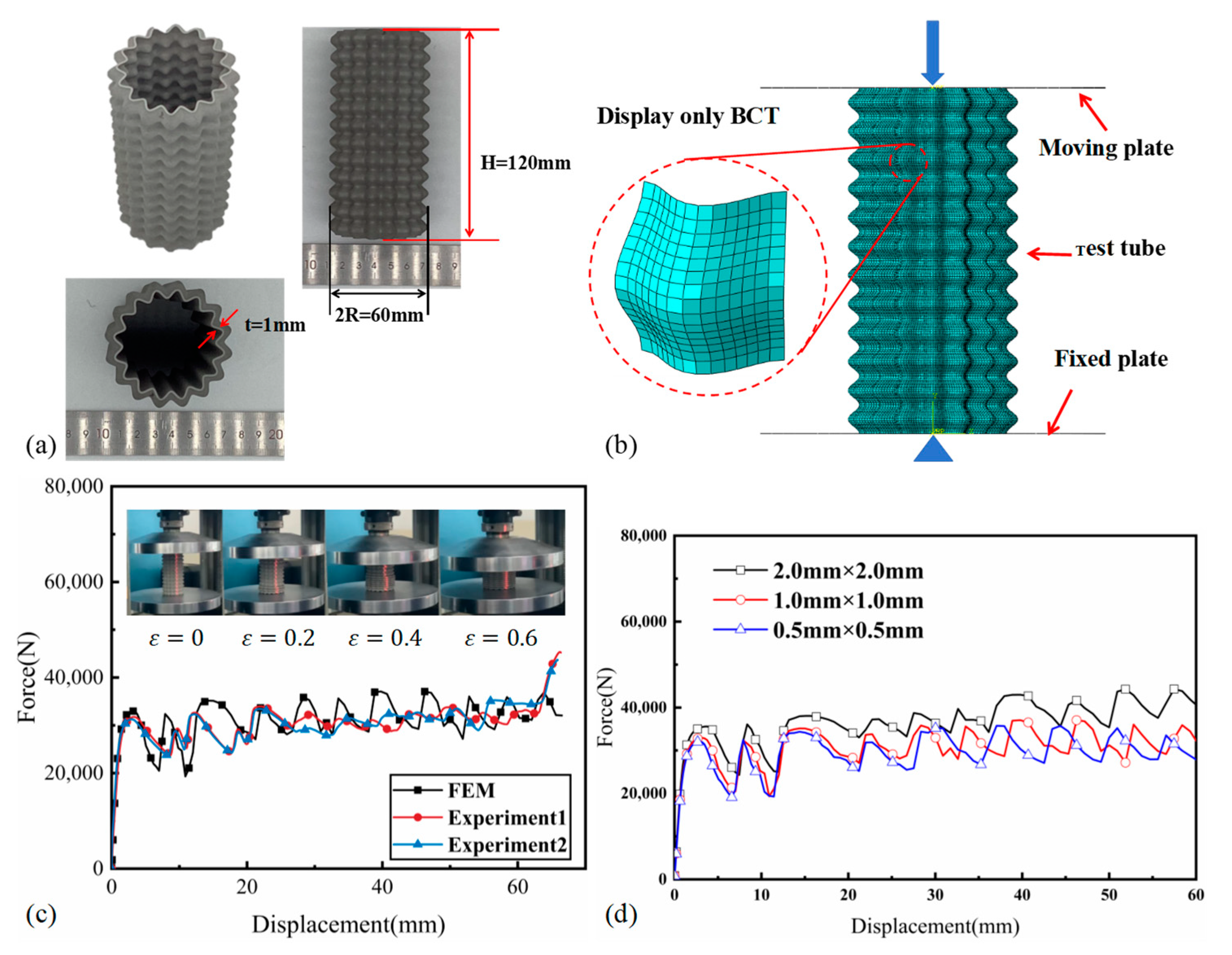
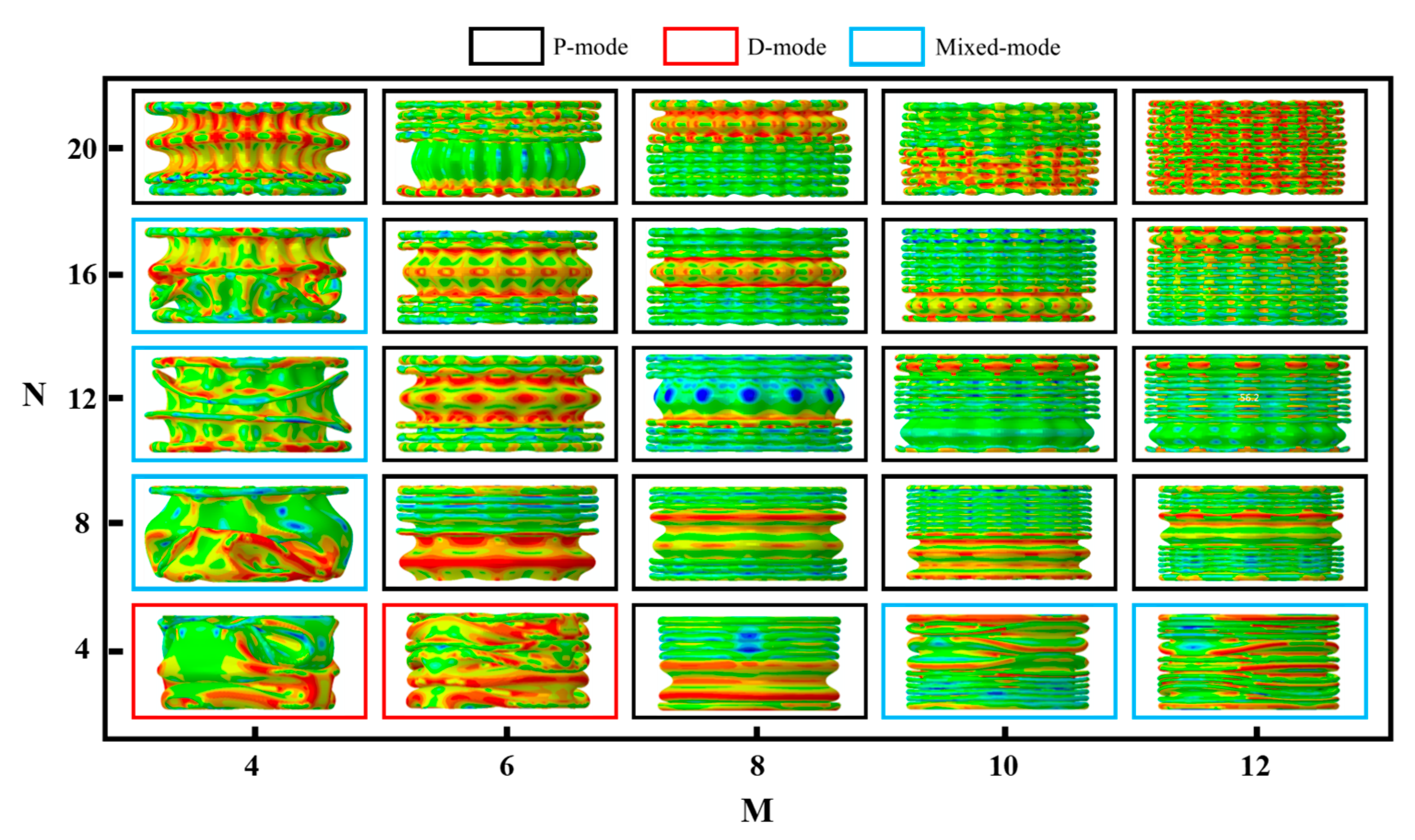
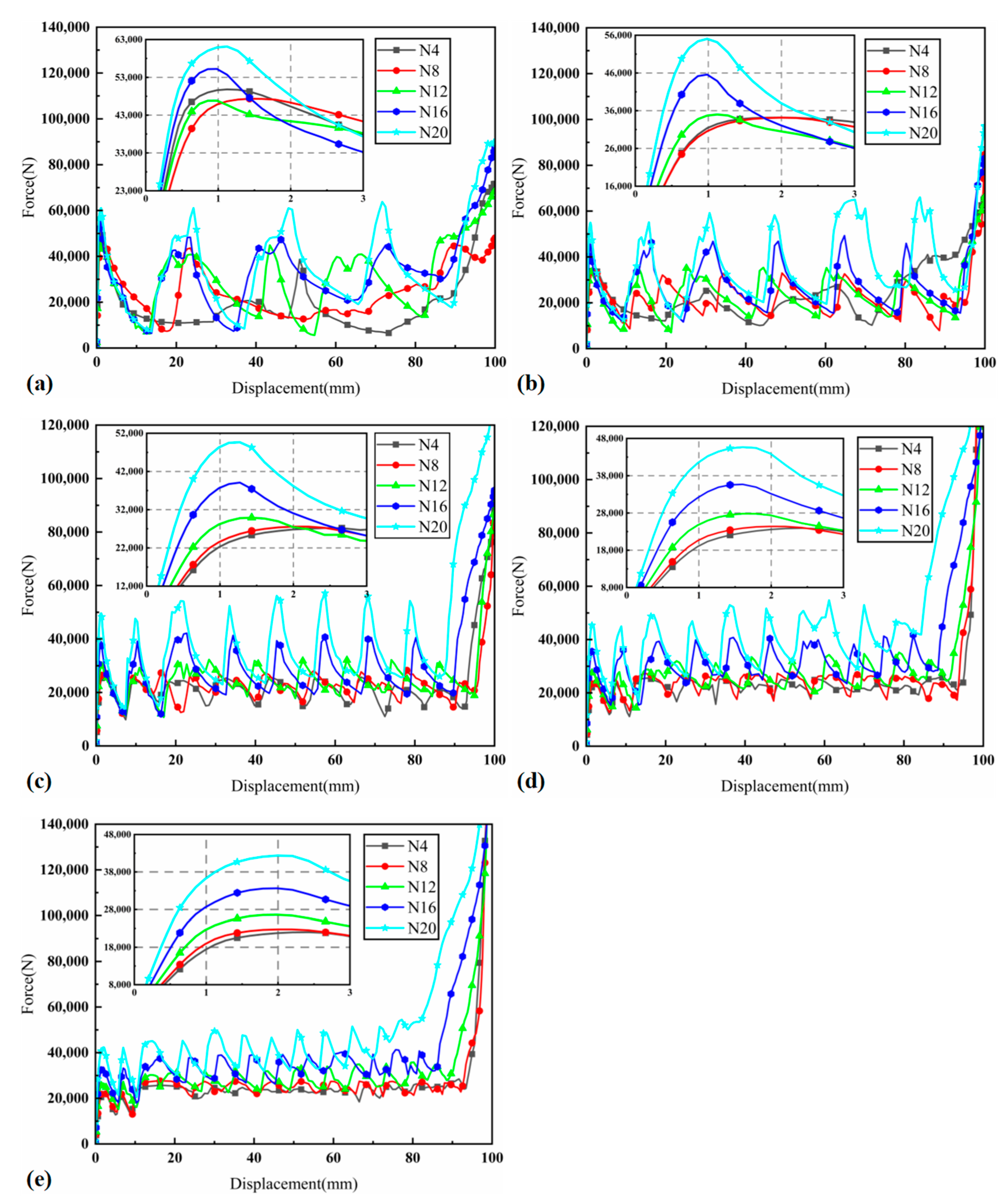
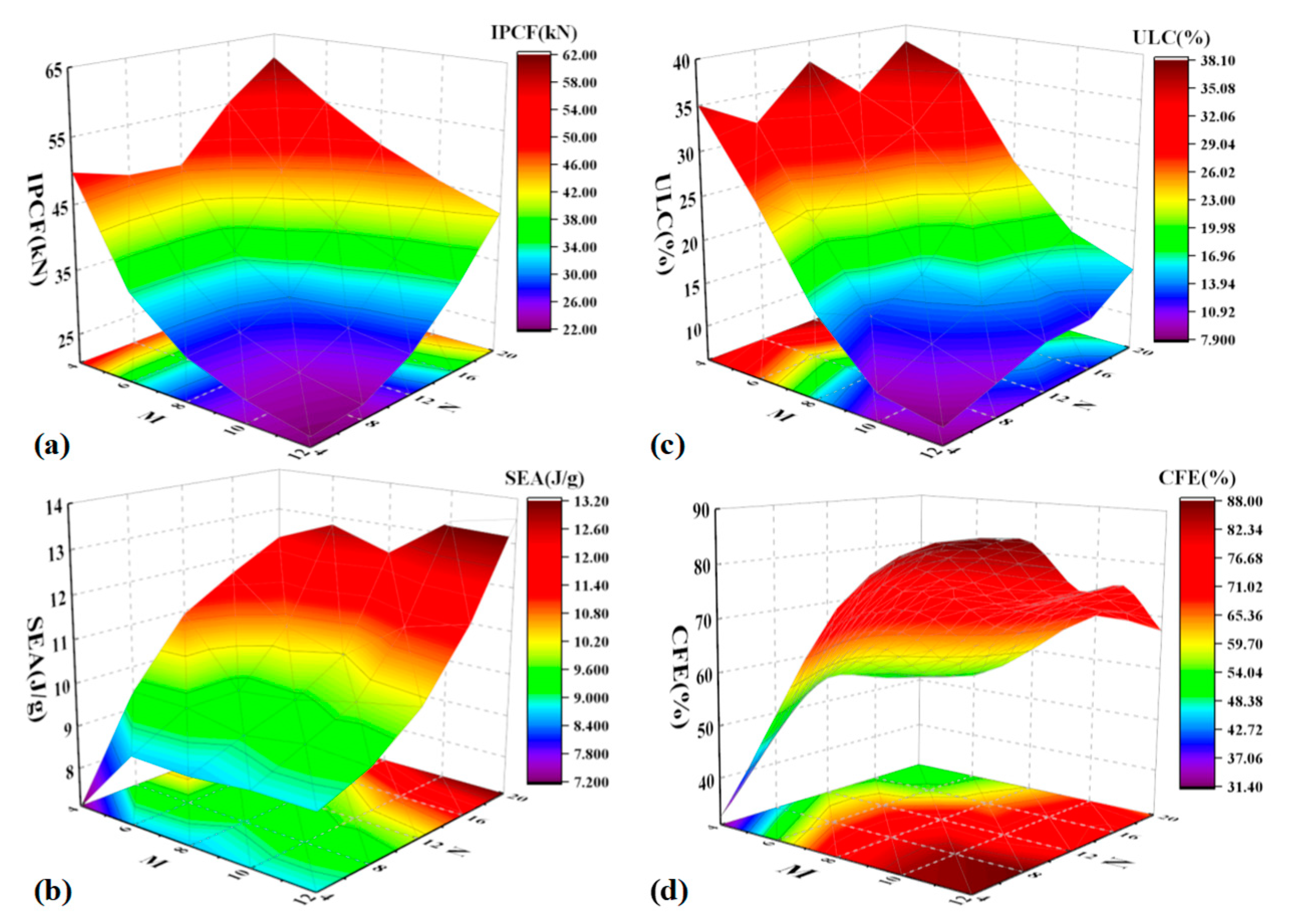

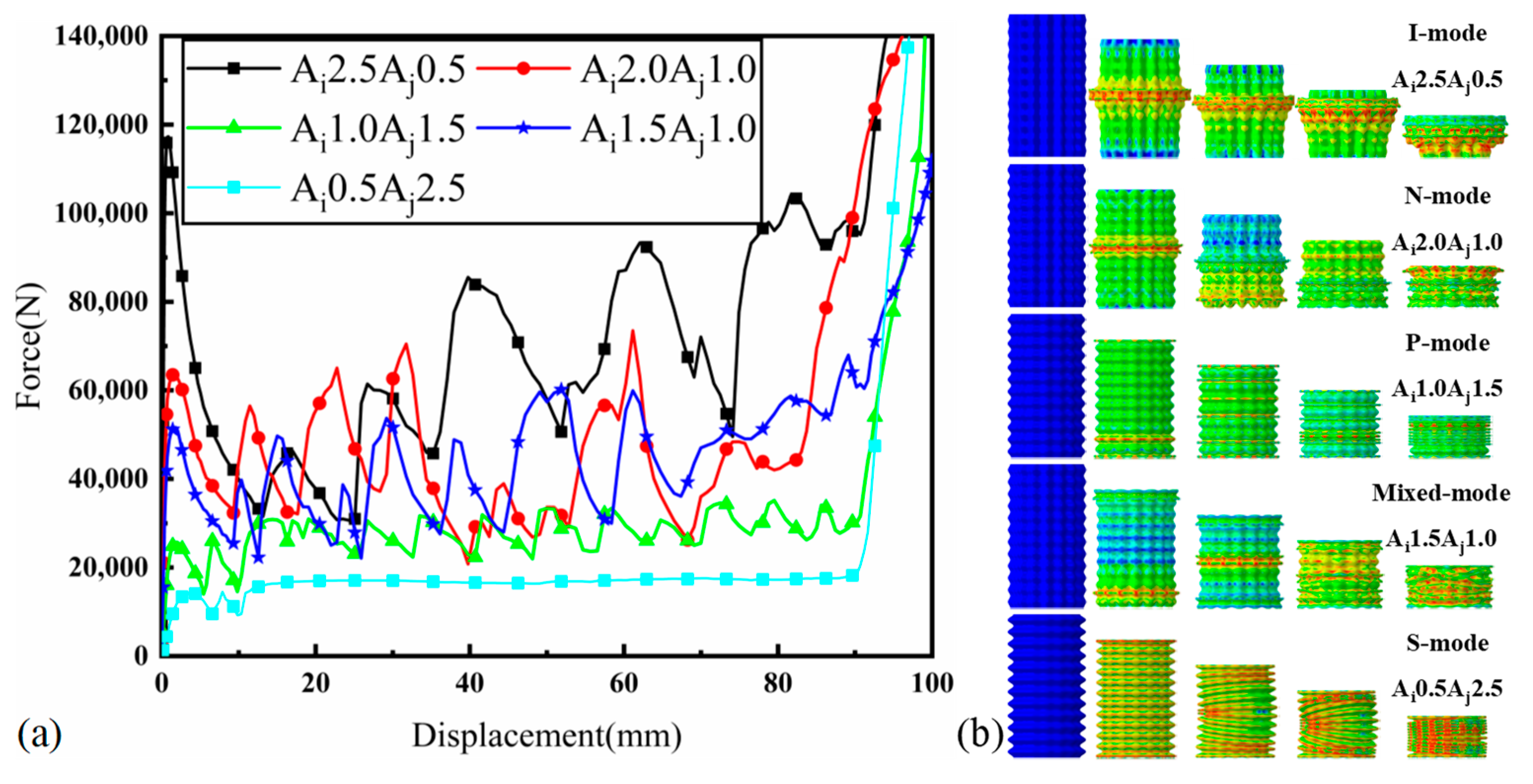
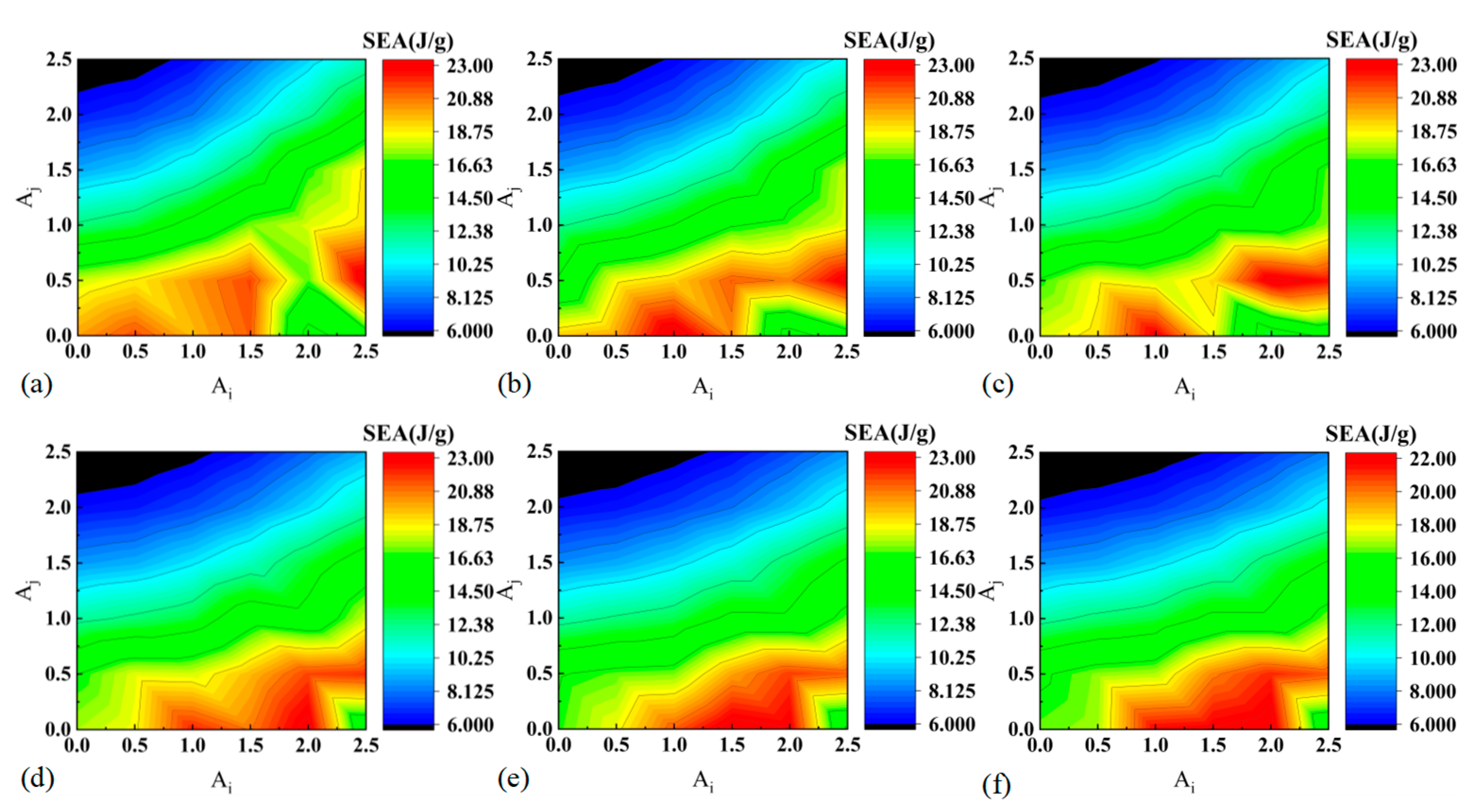

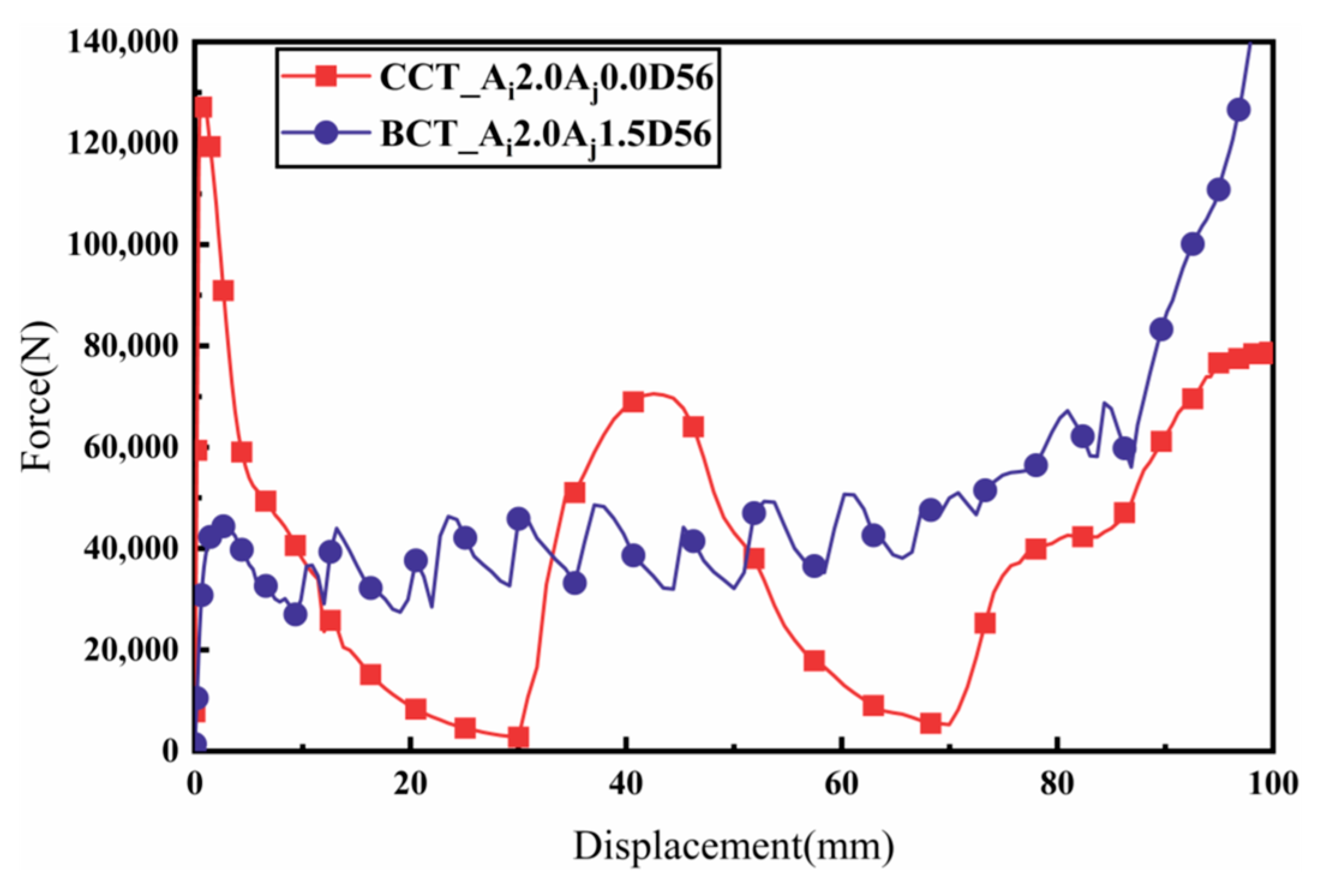


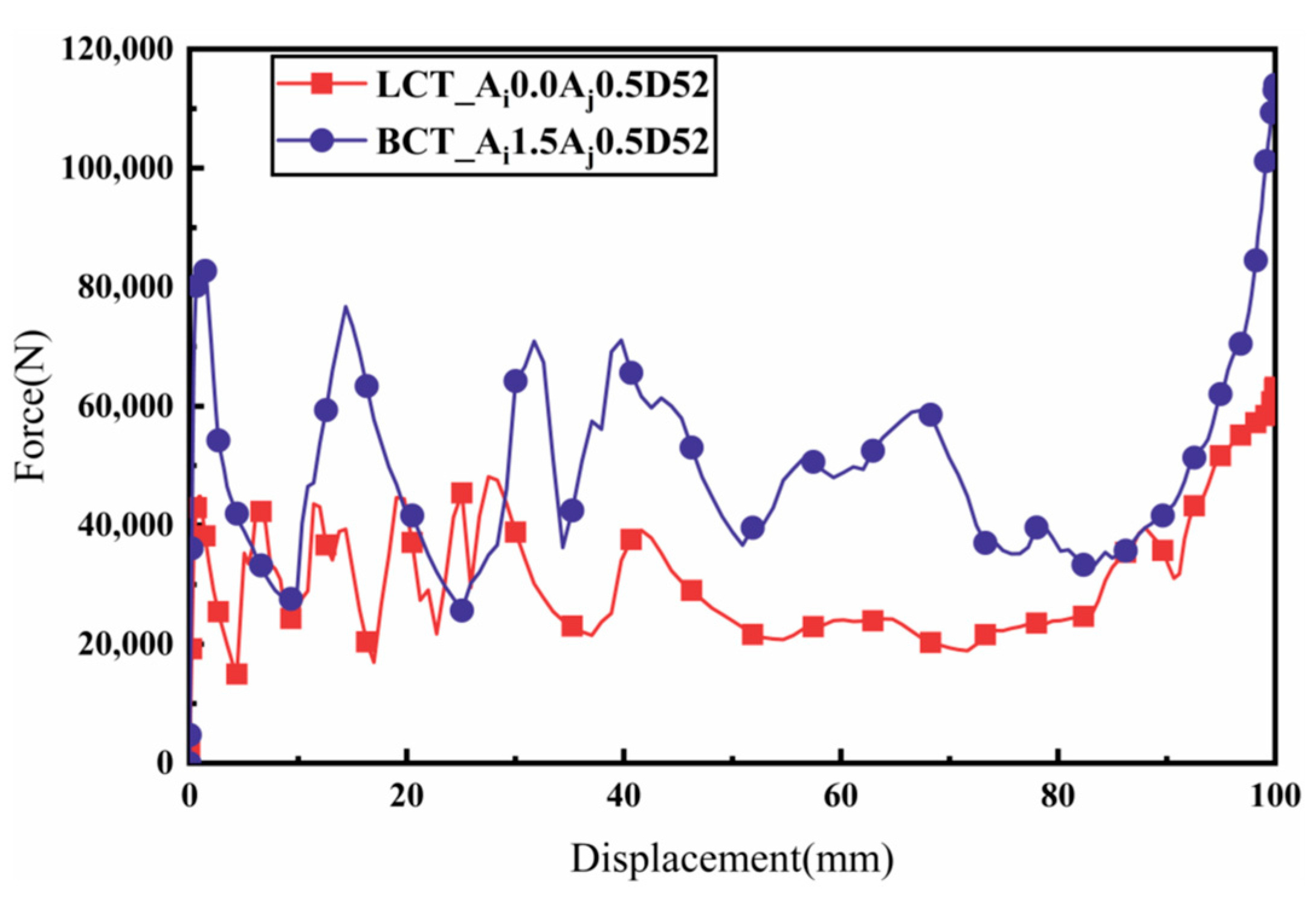
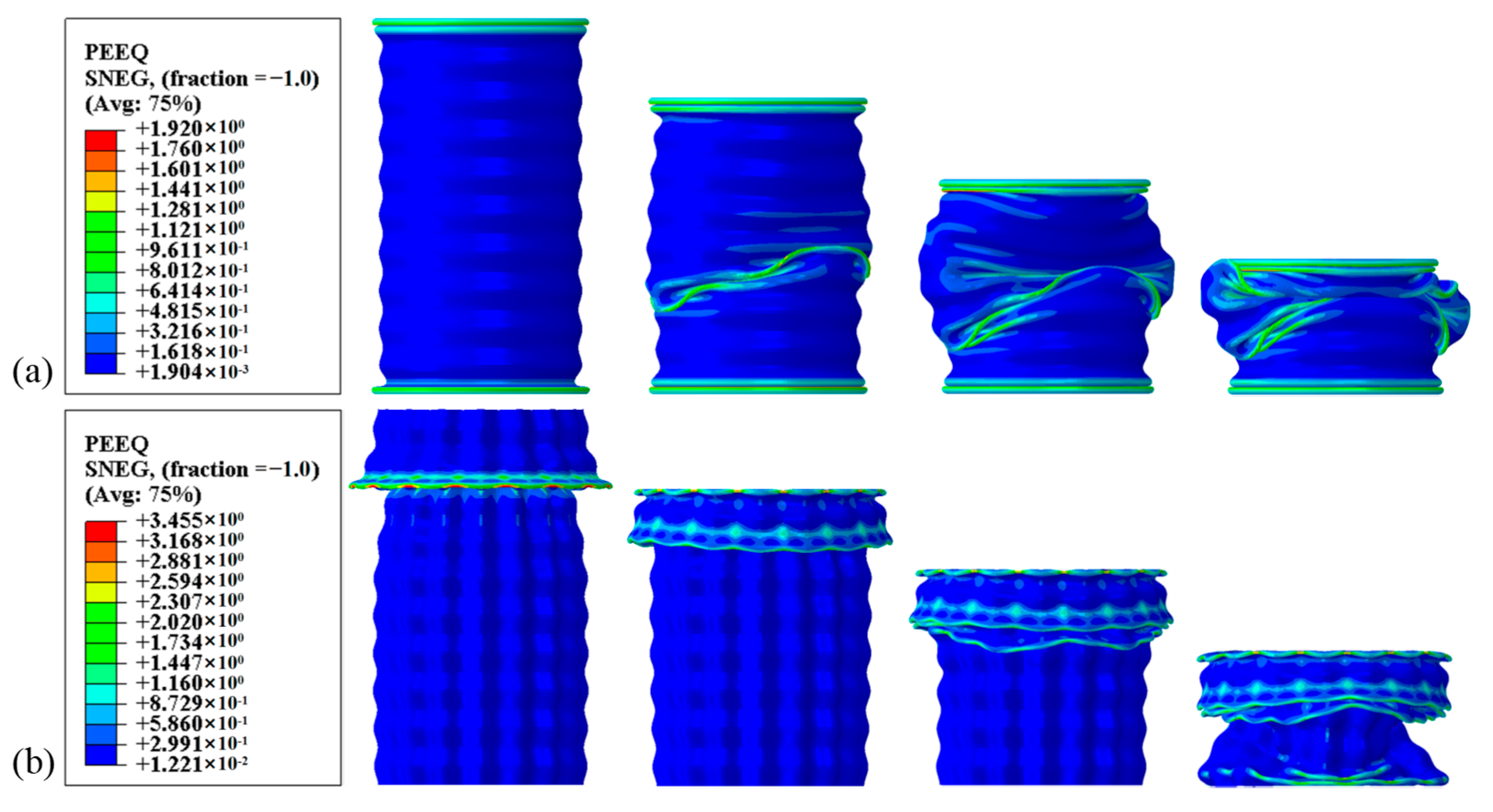
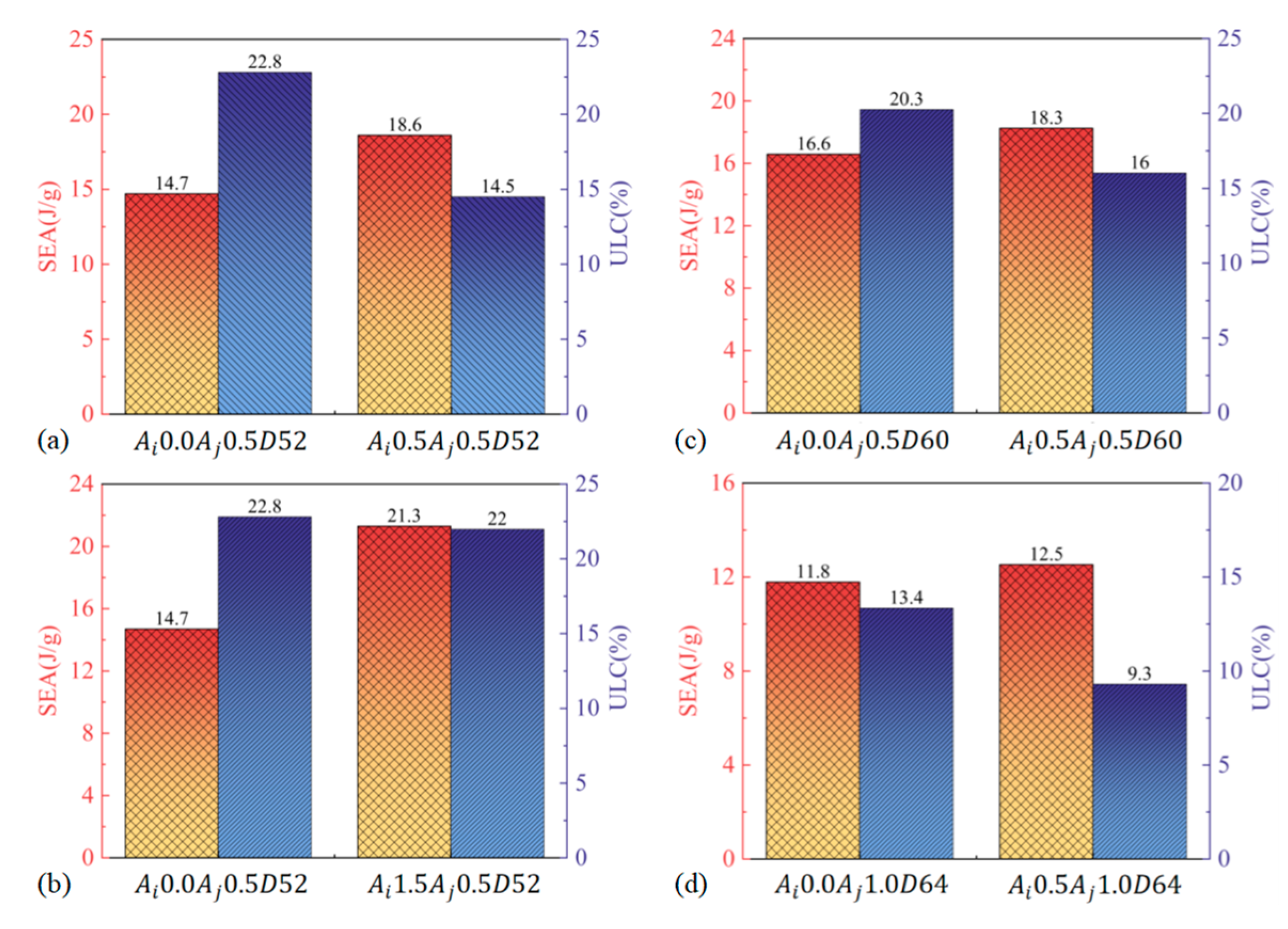
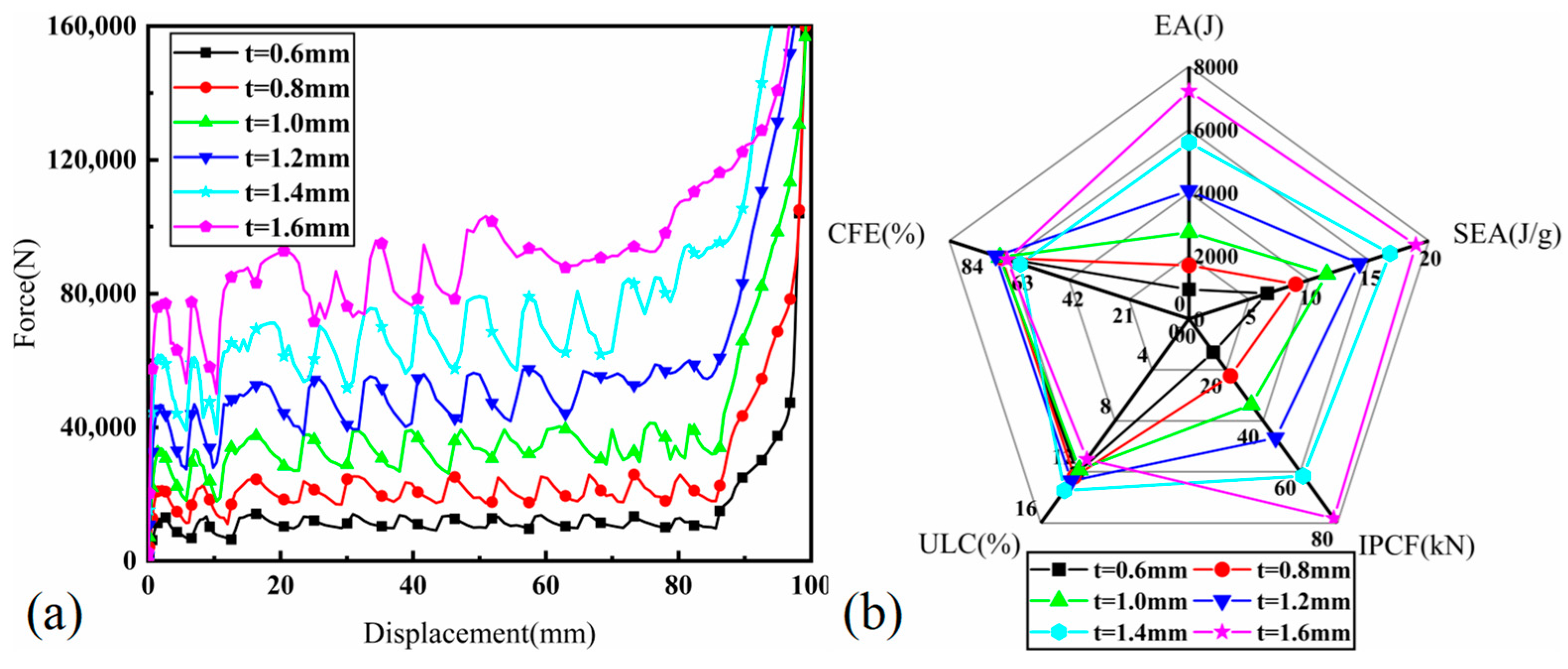

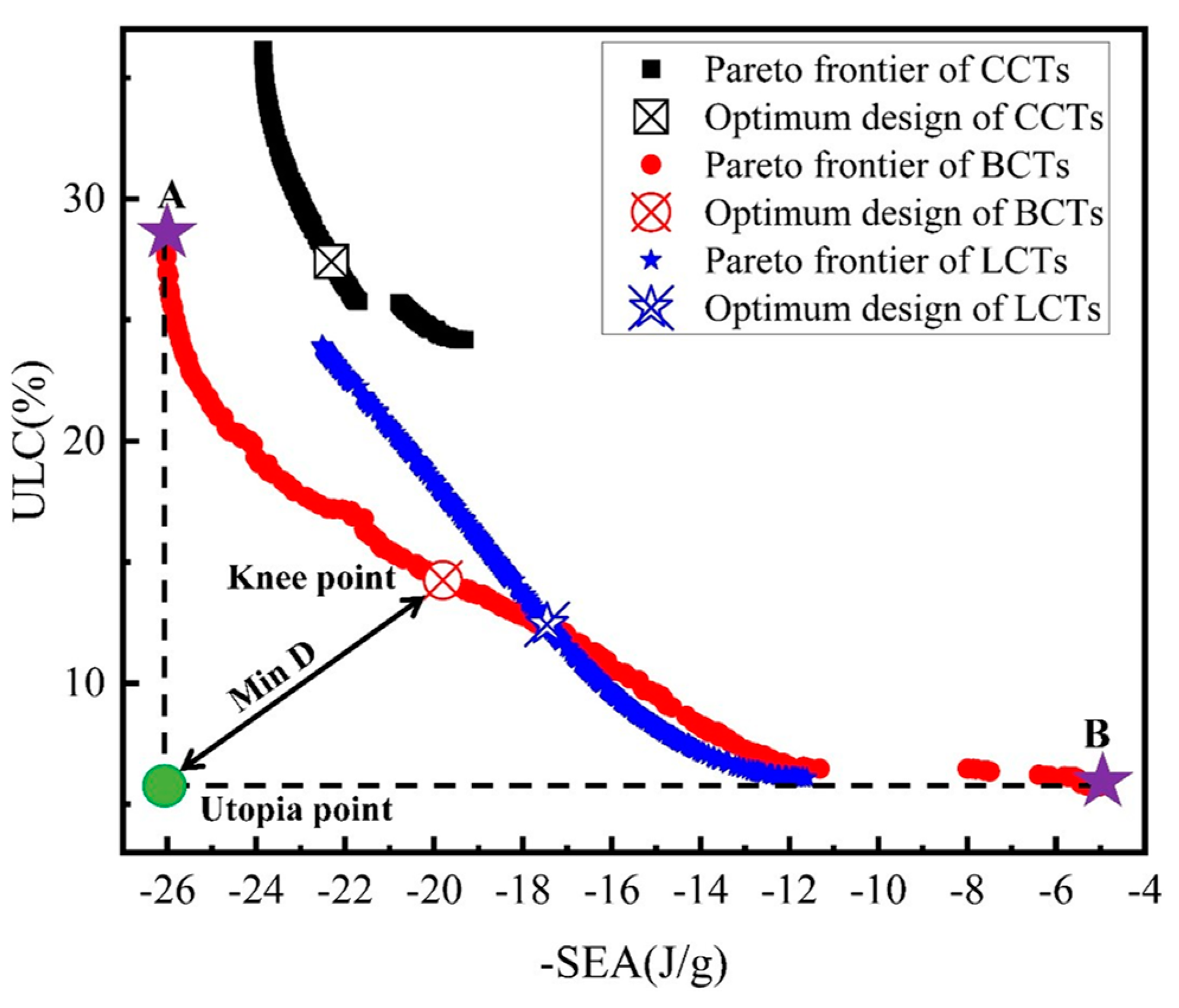
| specimen 1 | 243.3 | 30.37 | 1974.13 | 8.11 |
| specimen 2 | 242.8 | 30.42 | 1977.18 | 8.14 |
| FEM | 240.99 | 31.00 | 2014.98 | 8.36 |
| Parameters | Levels | Values |
|---|---|---|
| 6 | 0, 0.5, 1.0, 1.5, 2.0, 2.5 | |
| 6 | 0, 0.5, 1.0, 1.5, 2.0, 2.5 | |
| 6 | 48, 52, 56, 60, 64, 68 |
| Columns | Index | ||||
|---|---|---|---|---|---|
| BCTs | 0.9119 | 0.0572 | 0.2391 | 0.0924 | |
| 0.9370 | 0.0662 | 0.1400 | 0.0793 | ||
| CCTs | 0.9004 | 0.1113 | 0.2176 | 0.1264 | |
| 0.9357 | 0.0827 | 0.1399 | 0.0917 | ||
| LCTs | 0.9246 | 0.0887 | 0.1632 | 0.1021 | |
| 0.9704 | 0.0547 | 0.1047 | 0.0622 |
| Item | NSGA-II | FEA Results | Accuracies | |||||||
|---|---|---|---|---|---|---|---|---|---|---|
| RE | RE | |||||||||
| ) | (%) | ) | (%) | (%) | (%) | |||||
| Optimal BCTs | 1.55 | 1.19 | 51.27 | 1.35 | 19.80 | 14.25 | 20.22 | 13.70 | 2.12 | 3.86 |
| Item | Index | NSGA-II | RE (Compared to CCTs) | RE (Compared to LCTs) | |||||||
|---|---|---|---|---|---|---|---|---|---|---|---|
| ) | (%) | ) | (%) | ) | (%) | ||||||
| BCTs | Ideal max | 0.93 | 0.33 | 54.01 | 1.35 | 26.04 | 28.23 | 16.72 | 3.39 | 49.14 | 126.93 |
| Ideal min | 0.53 | 1.86 | 55.32 | 0.76 | 5.02 | 5.73 | −77.50 | −79.09 | −71.25 | −53.94 | |
| Optimal BCTs | 1.55 | 1.19 | 51.27 | 1.35 | 19.80 | 14.25 | −11.25 | −47.99 | 13.40 | 14.55 | |
| CCTs | Optimal CCTs | 0.09 | 0 | 50.01 | 1.35 | 22.31 | 27.40 | - | - | - | - |
| LCTs | Optimal LCTs | 0 | 0.83 | 50.00 | 1.35 | 17.46 | 12.44 | - | - | - | - |
Disclaimer/Publisher’s Note: The statements, opinions and data contained in all publications are solely those of the individual author(s) and contributor(s) and not of MDPI and/or the editor(s). MDPI and/or the editor(s) disclaim responsibility for any injury to people or property resulting from any ideas, methods, instructions or products referred to in the content. |
© 2024 by the authors. Licensee MDPI, Basel, Switzerland. This article is an open access article distributed under the terms and conditions of the Creative Commons Attribution (CC BY) license (https://creativecommons.org/licenses/by/4.0/).
Share and Cite
Zou, L.; Wang, X.; Wang, R.; Huang, X.; Li, M.; Li, S.; Jiang, Z.; Yin, W. Crashworthiness Performance and Multi-Objective Optimization of Bi-Directional Corrugated Tubes under Quasi-Static Axial Crushing. Materials 2024, 17, 3958. https://doi.org/10.3390/ma17163958
Zou L, Wang X, Wang R, Huang X, Li M, Li S, Jiang Z, Yin W. Crashworthiness Performance and Multi-Objective Optimization of Bi-Directional Corrugated Tubes under Quasi-Static Axial Crushing. Materials. 2024; 17(16):3958. https://doi.org/10.3390/ma17163958
Chicago/Turabian StyleZou, Liuxiao, Xin Wang, Ruojun Wang, Xin Huang, Menglei Li, Shuai Li, Zengyan Jiang, and Weilong Yin. 2024. "Crashworthiness Performance and Multi-Objective Optimization of Bi-Directional Corrugated Tubes under Quasi-Static Axial Crushing" Materials 17, no. 16: 3958. https://doi.org/10.3390/ma17163958






